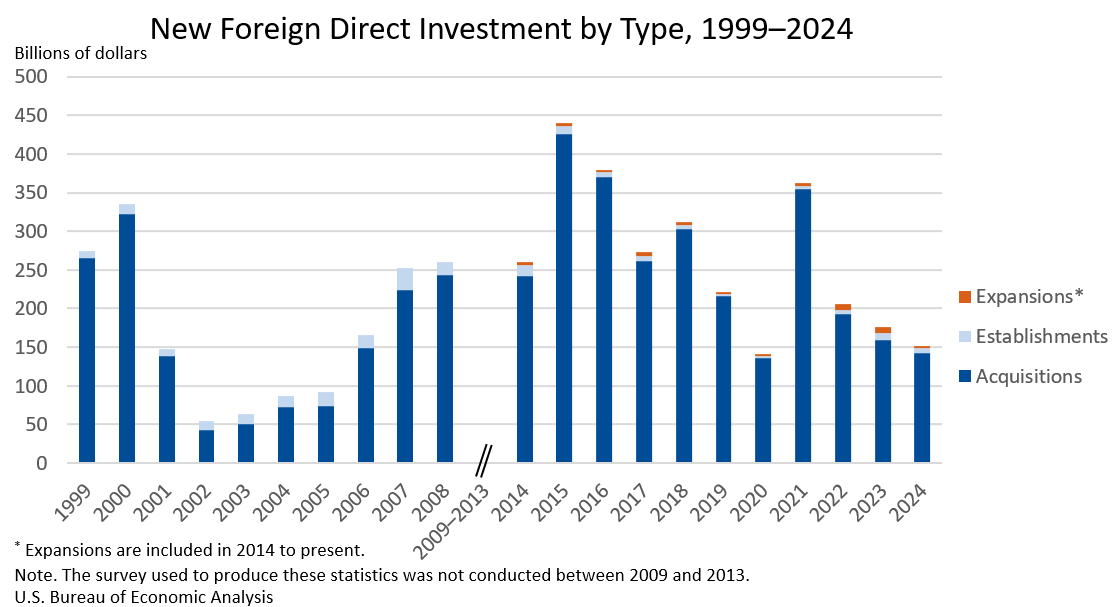Bureau of Economic Analysis
New Foreign Direct Investment in the United States, 2024
Expenditures by foreign direct investors to acquire, establish, or expand U.S. businesses totaled $151.0 billion in 2024, according to preliminary statistics released today by the U.S. Bureau of Economic Analysis. Expenditures decreased $24.9 billion, or 14.2 percent, from $176.0 billion (revised) in 2023 and were below the annual average of $277.2 billion for 2014–2023. As in previous years, acquisitions of existing U.S. businesses accounted for most of the expenditures.
Principal Federal Economic Indicators
Noteworthy
- 2025 News Release Schedule
- Innovation at BEA
- 2025 Annual Updates
- New! Services Trade Data for More Countries
- Data Tool: Trade in Value Added
- Distribution of State Personal Income
- Updated: RIMS II Regional Multipliers
- Arts and Culture
- Space Economy
- FDI Now in State BEARFACTS
- Quick Guide: Price Indexes
The Latest
New Foreign Direct Investment in the United States, 2024
Expenditures by foreign direct investors to acquire, establish, or expand U.S. businesses totaled $151.0 billion in 2024, according to preliminary statistics released today by the U.S. Bureau of Economic Analysis. Expenditures decreased $24.9 billion, or 14.2 percent, from $176.0 billion (revised) in 2023 and were below the annual average of $277.2 billion for 2014–2023. As in previous years, acquisitions of existing U.S. businesses accounted…
U.S. International Trade in Goods and Services, May 2025
The U.S. goods and services trade deficit increased in May 2025 according to the U.S. Bureau of Economic Analysis and the U.S. Census Bureau. The deficit increased from $60.3 billion in April (revised) to $71.5 billion in May, as exports decreased more than imports. The goods deficit increased $11.2 billion in May to $97.5 billion. The services surplus decreased $0.1 billion in May to $26.0 billion.
U.S. International Investment Position, 1st Quarter 2025 and Annual Update
The U.S. net international investment position, the difference between U.S. residents’ foreign financial assets and liabilities, was -$24.61 trillion at the end of the first quarter of 2025, according to statistics released today by the U.S. Bureau of Economic Analysis. Assets totaled $36.85 trillion, and liabilities were $61.47 trillion. At the end of the fourth quarter of 2024, the net investment position was -$26.54 trillion (revised).
Gross Domestic Product by State and Personal Income by State, 1st Quarter 2025
Real gross domestic product decreased in 39 states in the first quarter of 2025, with the percent change ranging from 1.7 percent at an annual rate in South Carolina to –6.1 percent in Iowa and Nebraska. Personal income, in current dollars, increased in all 50 states and the District of Columbia in the first quarter of 2025, with the percent change ranging from 12.7 percent at an annual rate in North Dakota to 3.2 percent in Washington state.
Personal Income and Outlays, May 2025
Personal income decreased $109.6 billion (0.4 percent at a monthly rate) in May, according to estimates released today by the U.S. Bureau of Economic Analysis. Disposable personal income (DPI)—personal income less personal current taxes—decreased $125.0 billion (0.6 percent) and personal consumption expenditures (PCE) decreased $29.3 billion (0.1 percent). Personal outlays—the sum of PCE, personal interest payments, and personal current transfer…
Gross Domestic Product, 1st Quarter 2025 (Third Estimate), GDP by Industry, and Corporate Profits (Revised)
Real gross domestic product (GDP) decreased at an annual rate of 0.5 percent in the first quarter of 2025 (January, February, and March), according to the third estimate released by the U.S. Bureau of Economic Analysis. In the fourth quarter of 2024, real GDP increased 2.4 percent. The decrease in real GDP in the first quarter primarily reflected an increase in imports, which are a subtraction in the calculation of GDP, and a decrease in…
U.S. International Transactions, 1st Quarter 2025 and Annual Update
The U.S. current-account deficit widened by $138.2 billion, or 44.3 percent, to $450.2 billion in the first quarter of 2025, according to statistics released today by the U.S. Bureau of Economic Analysis. The revised fourth-quarter deficit was $312.0 billion. The first-quarter deficit was 6.0 percent of current-dollar gross domestic product, up from 4.2 percent in the fourth quarter.
Expansion of State and Local Economic Stats Spurred by Innovations
A blog from BEA Director Vipin Arora
A consistent theme throughout the history of BEA and its forerunners—driven by significant public and policymaker demand—is the expansion of our regional statistics. This expansion began with the publication of our first annual statistics on state income payments in 1939, and has continued since.
Marine Economy Satellite Account, 2023
The Marine Economy Satellite Account statistics released today by the U.S. Bureau of Economic Analysis show the marine economy accounted for $511.0 billion, or 1.8 percent, of current-dollar U.S. gross domestic product in 2023, an increase from $482.4 billion in 2022. The marine economy accounted for $826.6 billion, or 1.7 percent, of current-dollar gross output in 2023.
U.S. International Trade in Goods and Services, April 2025
The U.S. monthly international trade deficit decreased in April 2025 according to the U.S. Bureau of Economic Analysis and the U.S. Census Bureau. The deficit decreased from $138.3 billion in March (revised) to $61.6 billion in April, as exports increased and imports decreased. The goods deficit decreased $75.2 billion in April to $87.4 billion. The services surplus increased $1.5 billion in April to $25.8 billion.




